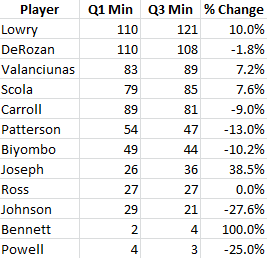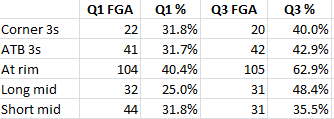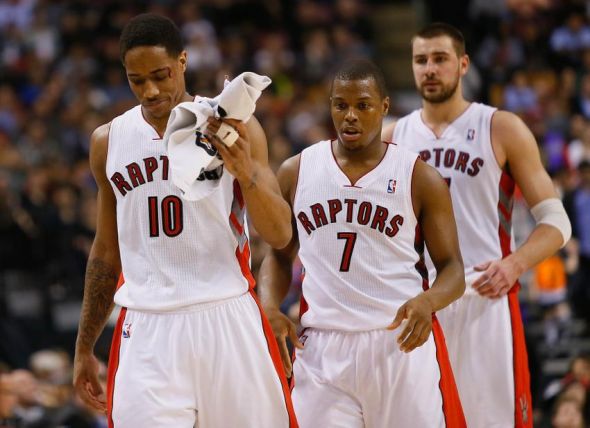Not every phenomenon has an explanation. Not every problem has a clear solution. Sometimes things just are, until they aren’t, at which point there’s little reason for post-facto analysis, if the cause of change was even anything other than unknowable randomness.
Whether or not Draymond Green suits up for the Golden State Warriors on Tuesday, the first three weeks of the NBA season suggest the Toronto Raptors will find themselves in an early hole. The Warriors are the league’s best team by a long shot, an undefeated defending champion, but that matters less than one might think as far as the Raptors and Tuesday’s opening quarter are concerned. The Raptors come out of the gate poorly against any competition.
Despite ranking eighth in offensive efficiency and 12th in defensive efficiency overall, good for seventh in net rating league wide, the Raptors have proven woefully incapable of getting off to good starts. Through 11 games, the 7-4 Raptors have gone 4-6-1 in opening quarters, getting outscored by a total of 28 points. On a per-possession basis, only three teams have a worse mark than the Raptors’ -12.4 net points per-100 possessions (PPC) in first quarters.
The problem is almost entirely on the offensive end of the floor, where the Raptors’ top-10 offense drops to a league-worst mark. And it’s not even close. The Raptors score 84.8 PPC in first quarters, five fewer than the next closest team, a veritable chasm between individual rankings.
This could perhaps stand as a reality of the team if there were an easy explanation like a weak starting lineup that feasts on opponent benches later, but that’s not even remotely the case. Largely the exact same group has outscored opponents by an obscene 18.1 PPC in third quarters, scoring 121 PPC in the process. The Raptors’ offense goes from a destitute version of the 76ers’ offense in the first to a supercharged version of the Warriors’ offense in the third – no team is even close to owning a single-quarter offensive efficiency like the Raptors’ third-quarter mark.
 The defense is fairly steady quarter by quarter – they actually play slightly worse at that end out of the break, but they more than make up for it on offense – and there’s little explaining the change in offense. The team, too, seems at a loss for what’s happening in those quarters.
The defense is fairly steady quarter by quarter – they actually play slightly worse at that end out of the break, but they more than make up for it on offense – and there’s little explaining the change in offense. The team, too, seems at a loss for what’s happening in those quarters.
“I don’t know,” head coach Dwane Casey said after Friday’s victory. “When you figure it out, let me know, we’ll go into business together. It’s a mystery.”
Asking around the locker room Friday, nobody seemed to have an explanation they were convinced of. After going over some potential root causes, it’s hard not to feel the same way.
Personnel, rotations
The most obvious explanation would be if Casey were managing the first and third quarters in fundamentally different ways. He’s not. The team has kept the same starters at the beginning of each half, and the minutes for each player have remained largely unchanged across first and third quarters. This is essentially the same group of players playing drastically different against the same group of opponents.
 Casey goes to his bench slightly slower in the third than in the first, but that’s a difference of, at most, one minute. That’s not nearly enough to explain any of this variance. There’s also no evidence to suggest that Casey has an inclination to stay with his starters longer than other coaches, as he followed a fairly common substitution pattern a season ago.
Casey goes to his bench slightly slower in the third than in the first, but that’s a difference of, at most, one minute. That’s not nearly enough to explain any of this variance. There’s also no evidence to suggest that Casey has an inclination to stay with his starters longer than other coaches, as he followed a fairly common substitution pattern a season ago.
Defense
Patrick Patterson and DeMar DeRozan both threw out defense as a potential reason behind the team’s lackluster offense early, which could make some sense. Were the Raptors forcing more turnovers and corralling more defensive rebounds, it would allow for the transition offense to flow, which makes for easier looks early in the shot clock.
“We got stops,” Patterson said of the team’s improved third-quarter play Friday. “The first half we couldn’t get stops. We had a lack of communication, lack of following orders as far as on the coverages, communicating bigs help, rotating over, just doing little things. The start of the third quarter, that first unit did a great job setting the pace and setting the tone for the entire second half.”
Again, that would be a great explanation, were it true.
The third happens to be the Raptors’ worst defensive quarter, and the two primary objectives that would help drive offense from the defense – turnovers and defensive rebounding – are mostly unchanged between quarters. The Raptors force slightly fewer turnovers in third quarters and grab slightly more defensive rebounds. The Raptors score an 1.6 additional fast-break points in third quarters, but that seems to be driven by something other than getting more or higher-quality stops.
Style, Pace
Pace of play has been an interesting topic to broach with Casey and the players, as the Raptors have fallen to a below-average pace after a fast start to the season. Casey says he wants to push things but avoid getting “frenetic,” and DeRozan and Patterson sounded as if they believe pushing things can help drive the offense.
“I think we felt that we were not playing the style of basketball that we knew we could play at both ends,” DeRozan said. “We had to pick it up and get some stops, try and get out in transition and change the tempo of the game to our pace.”
But playing faster hasn’t been the case in third quarters, either. The Raptors average 0.8 fewer possessions in third quarters than first quarters, though there is something to the theory that they’re getting better early-clock looks in third quarters.
The Raptors have taken nearly one additional shot per-game in third quarters that came within the first six seconds of the shot clock, and they’re shooting 63.9 percent on those early-clock looks in third quarters. Curiously, they’re shooting 34.5 percent on those same shots in the first quarter (more on that shortly). And cancelling out some of that edge is that the Raptors also shift some of their mid-clock shots to late-clock scenarios, taking an additional shot in third quarters with the clock under seven seconds.
The effects are small, but the Raptors seem to focus on early-clock shots in the third more…while also seeing their offense stall out a bit more, requiring late-clock heaves or forces. (It’s possible they’re just getting really good looks late in the clock, but their performance in those situations in other quarters suggests that’s unlikely.)
Always been a 3rd-quarter team
Someone commented somewhere on the site or Twitter that the Raptors have always been a third-quarter team. That was true last year, as they were 6.1 PPC better in the third than the first, but almost all of that impact came on the defensive end, not on offense. In 2013-14, they were actually a remarkably good first-quarter team that struggled in the third. Not that this would even really mean anything, other than to further perplex.
Intangibles
This is the area everyone is going to go to, because there’s no tangible reason behind the early struggles and later surges. When there’s no physical explanation for something, there must be a mental, psychological, or spiritual one, right? Here are a few more quotes from Friday as the team grasped at straws.
DeRozan: I don’t know. We might need to drink a 5 Hour Energy drink or a Red Bull. We just gotta get better at it, honestly. We just gotta get off to better starts and let that carry us over, and not necessarily always fight from behind. We’re a team, we like challenges for some reason. Once we get in a challenge, that’s when we pick it up, but we can’t play like that.
Casey: That first part of the game we were kind of running in mud, lethargic. We got going, I don’t know what it was, but we were not playing with any force at either end of the floor.
Casey: I think a lot of times guys try to feel the game out, not going and just put your stamp on it at the beginning of the game. That’s our next step – to go in and put our foot down and put our stamp on the game when the jump ball goes up.
Jonas Valanciunas: I don’t know. We’re letting teams get a strong start. I don’t know, we’ve gotta change that. That’s what we need to work on. Maybe focus more, bring a different energy from the start.
There’s no way to look into this or quantify it or know what’s at play. Casey laughed at my tongue-in-cheek suggestion that it was terrific coaching adjustments at the break leading to third-quarter charges, and he seems somewhat at a loss for how to change course.
“You can jump up and down before the game, yell, scream,” Casey said. “Whatever it is, some teams just go through that.”
Eleven games is still early enough that this may all be noise. If there is something psychological going on group-wide, there’s plenty of time to fix it. And if it’s an energy thing, maybe the expanded partnership with BioSteel will help (do they make energy drinks?).
Conclusion: They inexplicably shoot better
Alright, ready for the big conclusion? The Raptors just inexplicably shoot better in third quarters. Yup, that’s pretty much it.
Looking at their shot breakdowns, there’s not a whole lot to see other than that.
 The shot mix is almost the exact same, the Raptors just shoot better from every area of the floor in the third quarter. That’s especially true from the highest efficiency spots on the floor – outside the arc and at the rim.
The shot mix is almost the exact same, the Raptors just shoot better from every area of the floor in the third quarter. That’s especially true from the highest efficiency spots on the floor – outside the arc and at the rim.
 The Raptors even assist on a higher percentage of their first-quarter baskets, so it’s not as if they’re moving the ball substantially better in the third frame.
The Raptors even assist on a higher percentage of their first-quarter baskets, so it’s not as if they’re moving the ball substantially better in the third frame.
The one area that provides some explanation is a higher free-throw rate in the third quarter. The Raptors are already quite strong in that regard and the difference is less than an attempt per game, but it seems worth noting that they do draw slightly more fouls in third quarters. That may not only provide an additional point but change the way the defense plays against them, should they get into foul trouble earlier.
What to do
“It’s hard to live that way. It makes it hard on yourself, especially against good teams.”
That was Casey on Friday, after the Raptors had followed their usual formula against a banged-up New Orleans Pelicans squad that probably can’t be described as “good” right now. The Raptors survived slow starts against New Orleans and Philadelphia, and Indiana and Oklahoma City before that, but that’s going to be death against the Warriors. It’s also going to make things extremely difficult as this five-game road trip wears on and fatigue sets in. It’s not a tenable way to play. Whatever the solution, the Raptors need to hope they find it Tuesday.
On the bright side, like with the shooting struggles that were plaguing the team as recently as a week ago, the first-quarter problem may be self-correcting to a degree. Regression is a wonderful ally when things are awry.



